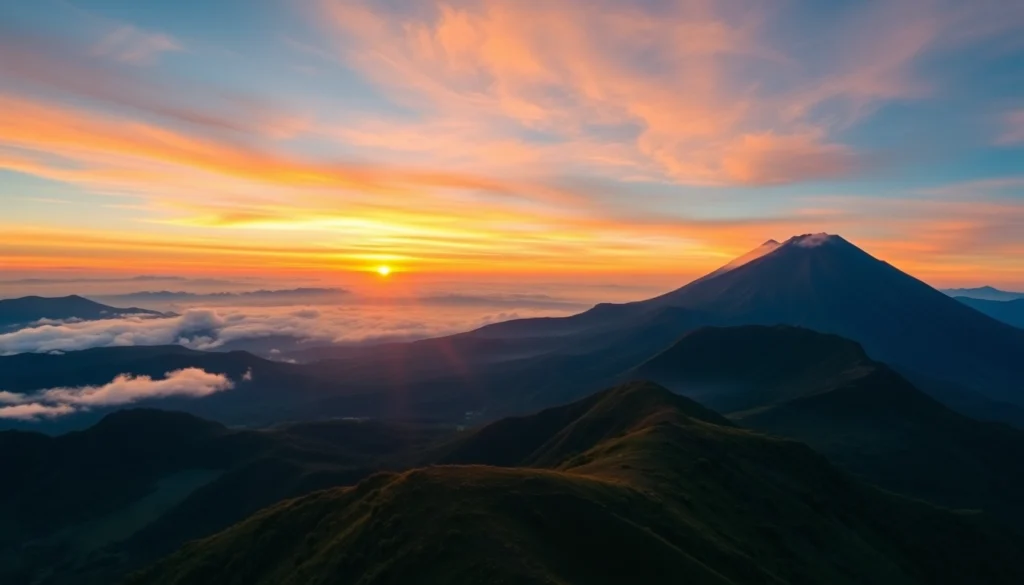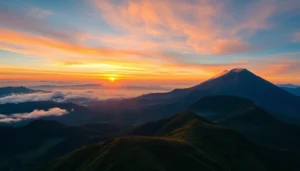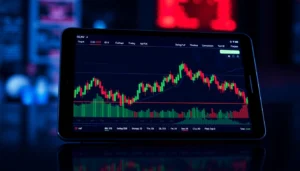Complete Guide to Mt. Rinjani: Height, Trekking Tips, and Visitor Insights

Introduction to Mt. Rinjani: Indonesia’s Second Highest Volcano
Nestled on the serene island of Lombok, Indonesia, Mt. Rinjani stands as a majestic testament to the region’s volcanic activity and natural beauty. Towering at an elevation of 3,726 meters, it is the second-highest volcano in Indonesia and one of the most iconic landmarks in Southeast Asia. The mountain’s formidable presence has drawn adventurers, nature lovers, and cultural enthusiasts alike, eager to explore its diverse landscapes, rich ecosystems, and ancient volcanic history. Exploring Mt. Rinjani offers not only a challenging trek but a window into the geological and cultural tapestry that defines Lombok and the surrounding Nusa Tenggara Barat.
Geographical Location and Significance
Mt. Rinjani is situated in the northern part of Lombok Island, within the boundaries of Gunung Rinjani National Park. This protected area spans over 41,000 hectares and is recognized as a significant biodiversity hotspot. The mountain is part of the Pacific Ring of Fire, a circle of active volcanoes that define much of the geology of Southeast Asia and the Pacific. Rinjani’s strategic location as an active volcanic massif contributes not only to the island’s topographical diversity but also to its ecological richness, fostering a unique mix of flora and fauna endemic to the transition zone between Wallacea and the Australian continental shelf.
The volcano plays a vital role in regional culture and spirituality, influencing local beliefs and practices. It is considered sacred by the Sasak people and other indigenous communities. Additionally, Rinjani’s eruptions have historically shaped the landscape, creating fertile volcanic soils that support vibrant agricultural activities on the island.
Historical Eruptions and Volcanic Activity
As an active volcano, Mt. Rinjani has experienced numerous eruptions throughout history, with the most recent significant activity recorded in December 2015. This eruption lasted for nearly two months, producing ash plumes that rose up to 6 kilometers into the atmosphere and lava flows that reshaped parts of the crater and surrounding slopes. Such activity underscores Rinjani’s unpredictable nature, necessitating continuous monitoring and preparedness.
The eruptions have contributed to the volcanic landscape’s complexity, creating features such as the caldera, hot springs, and crater lake, Segara Anak, which is regarded as one of the most stunning volcanic lakes in the world. The volcanic activity also provides a unique opportunity for scientists to study the dynamic processes of Earth’s geology and improve forecasting models for future eruptions.
Why Mt. Rinjani Attracts Adventure Seekers
Mt. Rinjani’s towering elevation and rugged terrain make it a magnet for trekkers and mountaineers seeking a challenging ascent. The diverse landscape—from lush forests and waterfalls to stark volcanic craters—provides an unparalleled trekking experience. Adventure enthusiasts are drawn by the thrill of summiting one of Indonesia’s highest peaks, witnessing spectacular sunrises from the summit, and exploring diverse ecosystems along the way.
Furthermore, the mountain offers cultural experiences with local communities, traditional ceremonies, and interaction with indigenous Sasak and Lombok people. Organized treks, guided expeditions, and eco-tourism initiatives have developed to accommodate these interests, making Rinjani a versatile destination for those chasing adventure, natural beauty, and cultural immersion.
Height and Physical Characteristics of Mt. Rinjani
Exact Elevation and Measurement Data
Officially measured at 3,726 meters above sea level, Mt. Rinjani ranks as the second tallest volcano in Indonesia, surpassed only by Mount Kerinci on Sumatra. Precise measurements have been obtained through satellite data, GPS surveys, and historical records, affirming its status as a significant high-altitude volcanic feature.
Its prominence and isolation contribute to the breathtaking panoramic views from its summit, offering vistas of neighboring islands, Lombok’s coastline, and the surrounding archipelago. The elevation influences local climate patterns, with cooler temperatures at the summit and a marked variation in flora from base to peak.
Distinctive Features and Crater Lake
One of Mt. Rinjani’s most notable features is the caldera, which measures approximately 60 km in circumference and houses the stunning crater lake, Segara Anak. This lake, with its azure waters and steaming hot springs, provides a stark contrast to the rugged volcanic landscape around it. Its geothermal activity contributes to the area’s rich biodiversity and offers thermal hot springs, such as the famously therapeutic Sara Hot Springs.
The summit itself features a volcanic cone, called the Rinjani Peak, which is often snow-capped in the dry season or shrouded in clouds. The overall physical structure showcases multiple volcanic vents, lava domes, and ash deposits, offering valuable insights into Rinjani’s eruptive history and ongoing geological processes.
Understanding Its Geological Composition
Geologically, Mt. Rinjani is primarily composed of andesitic and dacitic volcanic rocks, characteristic of stratovolcanoes. Its structure results from repeated explosive eruptions and lava flows, creating layers that record centuries of activity. The mountain’s composition influences its eruptive behavior—ranging from effusive lava flows to highly explosive ash plumes.
The presence of geothermal activity beneath the mountain suggests a complex magma system that remains active and capable of future eruptions. Ongoing monitoring by volcanological agencies helps mitigate risks and ensures the safety of visitors and local communities.
Trekking and Visiting Mt. Rinjani: Essentials and Best Practices
Popular Routes and Duration
There are two primary trekking routes to the summit of Mt. Rinjani: the Sembalun route and the Senaru route. The Sembalun route, starting from the east, is considered slightly more challenging due to its steeper inclines but offers a more gradual ascent and spectacular views of the caldera. The Senaru route, from the north, is longer but easier, favored by beginners.
A typical multi-day trek spans 3 to 4 days, with the most popular being a 4-day, 3-night expedition. This allows trekkers ample time to acclimate, explore the crater lake, and enjoy the sunrise from the summit. Treks usually culminate with a sunrise view from the peak, an awe-inspiring experience capturing the mountain’s majestic landscape.
Preparation, Equipment, and Safety Tips
Preparing for a Mt. Rinjani trek requires meticulous planning. Fitness levels should be adequate, as high-altitude hiking in variable weather can be demanding. Essential gear includes sturdy hiking boots, layered clothing for temperature changes, windproof jackets, gloves, hats, and sufficient water and high-energy snacks. A detailed packing list can be found on official trekking guides and must be followed for safety.
Altitude sickness awareness is crucial; acclimatization days are recommended. Trekkers should also carry a personal first aid kit, including medications for altitude sickness, and be prepared for sudden weather shifts. Experienced guides and porters enhance safety, support logistics, and provide local cultural insights.
Guides, Permits, and Cultural Tips
Hiring certified guides not only ensures safety but enriches the experience with local stories and cultural knowledge. Guides typically charge between Rp. 350,000 to Rp. 1,400,000 depending on the duration and inclusions, as outlined in recent trekking budgets. Permits are mandatory and can be arranged through local offices or agency packages.
Respect for local customs, sacred sites, and environmental conservation practices is vital. Avoiding littering, staying on designated trails, and engaging respectfully with local communities contribute to responsible tourism. Learning basic Indonesian phrases or local greetings fosters positive interactions.
Wildlife and Natural Attractions in Rinjani National Park
Flora and Fauna Unique to the Area
The park hosts a diverse array of flora, including rainforests, mossy trees, and endemic orchids. Animal species include Rinjani’s endemic primates such as the Lombok Monkey, various bird species like the Rinjani Scops Owl, and numerous reptiles. The rich biodiversity underscores the ecological importance of conservation efforts.
Must-Visit Waterfalls and Hot Springs
Within the park, several waterfalls such as Sendang Gila and Tiu Teja offer scenic spots for relaxation and photography. Hot springs like Sara Hot Springs provide warmth and therapeutic benefits after a challenging trek. These natural attractions enhance the overall experience for visitors seeking both adventure and tranquility.
Conservation and Responsible Tourism
As one of Indonesia’s protected areas, Rinjani National Park emphasizes sustainable tourism practices. Visitors are encouraged to minimize environmental impact, participate in clean-up efforts, and support local conservation initiatives. Respecting wildlife habitats and cultural sites ensures that future generations can enjoy Rinjani’s splendor.
Planning Your Trip to Mt. Rinjani: Resources and Recommendations
Best Seasons and Weather Conditions
The optimal period for trekking in Rinjani is during the dry season, from May to October. During these months, the weather is generally clear, and the risk of rain and fog is minimal, ensuring safer and more enjoyable climbs. The wet season, from November to April, presents challenges such as slippery trails, increased risk of landslides, and potential volcanic activity.
Accommodation and Local Support Services
Base camps and village accommodations are available in Sembalun, Senaru, and surrounding areas. Options range from simple homestays and guesthouses to more organized trekking packages that include guides, permits, meals, and equipment rentals. Prior booking, especially during peak seasons, is advisable to secure availability.
FAQs and Essential Visitor Information
Essential questions often concern trek costs, duration, safety, and permit requirements. For instance, the average guide fee is about Rp. 350,000 per day, with total costs varying by package. Trekking typically takes 3-4 days, with permits arranged through local agencies. Visitors should check weather updates and volcanic activity reports before embarking.




